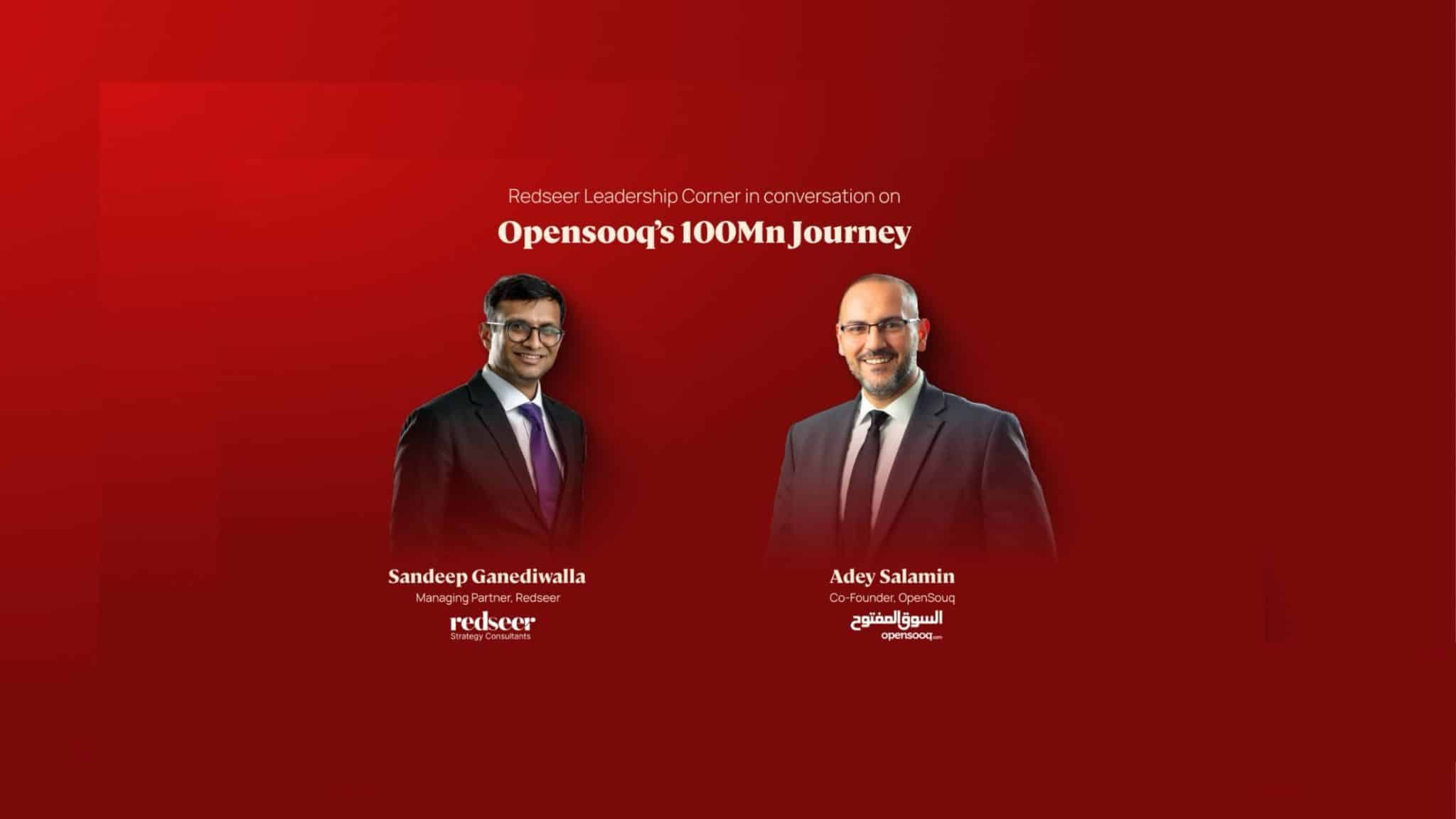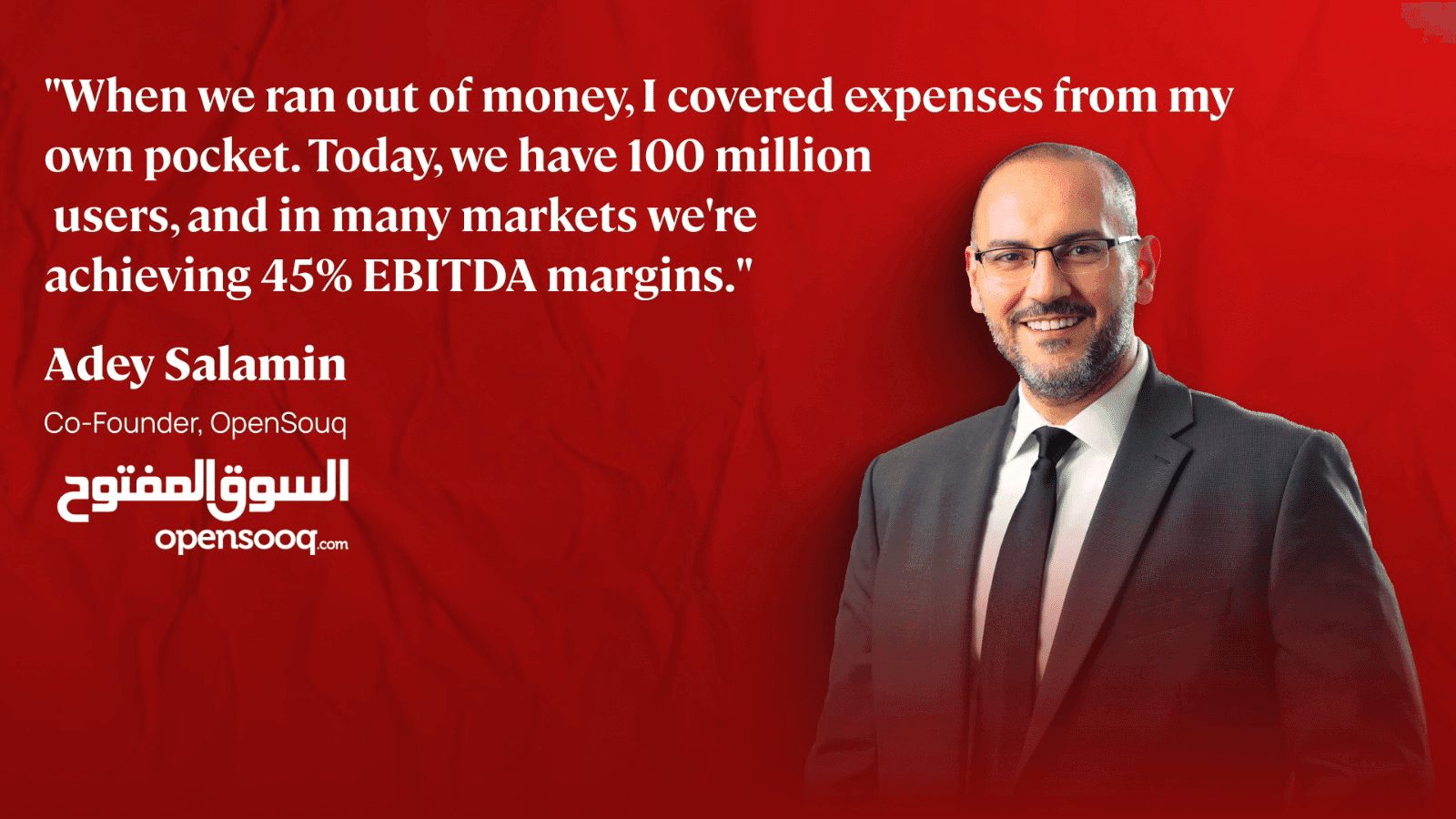
Opensooq’s 100m Journey: A Conversation with Adey
An interview between Sandeep Ganediwalla, Partner at Redseer, and Adey Salamin, Co-founder of OpenSooq
Introduction
Build new product innovation and market strategy.
MENA startup ecosystem typically spotlights success stories from UAE and Saudi Arabia. OpenSooq offers a compelling alternative narrative. Boasting 100+ million users and generating billions of monthly page views, the classifieds platform strategically deprioritized these premium markets in its initial growth phase. Instead, OpenSooq established market leadership in underserved regions including Jordan, Libya,Oman and many more.
This strategic approach challenges conventional market-entry frameworks. Yet it has enabled OpenSooq to develop capital-efficient operations while maintaining what they report as the lowest funding-to-user ratio among global classifieds platforms, all while achieving substantial scale and profitability.
We wanted to explore this differentiated expansion strategy to understand how OpenSooq built significant regional market share without initially targeting the high-value markets that traditionally dominate investor interest. The insights on strategic market selection, operational efficiency, and value creation in emerging economies present valuable lessons for regional expansion strategies. Here’s a snippet of our conversation:
Early Beginnings and Entrepreneurial Roots
Sandeep: How did OpenSooq get started? What was your strategy in the early days?
Adey: One of the key successes early on was our word-of-mouth strategy. We didn’t have much money when we started—we’ve been the least funded classifieds company per capita globally.
My journey in classifieds actually started before OpenSooq. In 2004, I came back from the US and started what I believe was the first classifieds platform in the region called Asuaq, meaning “markets.” I couldn’t even raise $50,000 for the website then.
Sandeep: My god, that was before the iPhone came out in 2006. What inspired you to start in classifieds?
Adey: My interest came from my experience in the US. The first car I bought during college was through Craigslist for $1,200. I sold it three months later for around $3,600. That’s when I realized there was money in these transactions. When I returned to the region, I saw nothing like Craigslist existed here.
The Formation of Opensooq
Sandeep: So, how did OpenSooq start?
Adey: OpenSooq was founded by Salah Al Sharif, who was based in Libya. It was a small website with just two part-time developers. I had to decide whether to continue with Asuaq or invest in OpenSooq.
Salah was number one in Libya with around 15-20 million page views. He was focused on product, and I thought we could complement each other with my regional knowledge and management capabilities.
We invested with the condition that he move to Jordan. He became the product lead and we started growing in Jordan after Libya. From there, we expanded regionally.
Sandeep: And what’s your reach now?
Adey: We’ve grown from 15 million page views to over two billion monthly. Last year we had over 100 million unique users across the region.
Growth Strategy: Market Selection and Funding Challenges
Sandeep: You know, Adey, I must say it is intriguing that your market entry strategy seems so counterintuitive to the outsider. Why did you avoid Dubai and Saudi initially?
Adey: When you don’t have enough funding, you need to make tough choices. Do you start a journey knowing you don’t have enough runway to win competitive markets? Or do you become the aggregator of smaller markets where there’s less competition?
We chose to be the aggregator of smaller markets that other players wouldn’t consider a priority and then expanded to higher valued economies. Why would someone from Europe think about a market with only 3-5 million people?
Sandeep: So becoming the big fish in smaller ponds was strategic?
Adey: Exactly. Being first creates a local barrier to entry. You become the number one player in these countries, making it harder for others to compete. Then you can start monetizing.
The downside was a longer journey. We split markets into short-term, medium-term, and long-term opportunities. In Jordan, we spent less than $1 million in marketing to win that market.
Market Presence and Competitive Position
Sandeep: Where are you the market leader today?
Adey: We’re number one in Jordan, Libya, Oman, Iraq, Palestine, and Yemen. We lost Syria and Sudan due to regional instability. We’re arguably number one or two in Kuwait, and number two in Saudi for horizontal classifieds.
In the UAE, we’ve grown 80% year-on-year for the last three or four years despite the competition. While classifieds are often considered winner-take-all, certain markets can sustain a second player.
Sandeep: And what do you think is your competitive advantage in markets like UAE?
Adey: Markets with high expat populations like UAE change quickly with people constantly coming and leaving. This creates opportunities. When competitors go aggressive on monetization, it opens windows. As Jeff Bezos said, “Your margin is my opportunity.”
Product Focus and Operating Strategy
Sandeep: How do you organize your business verticals?
Adey: We have a four-quadrant vertical focus:
- Automotive
- Property
- Intangibles (jobs and services, particularly blue-collar jobs)
- C2C goods (anything physical that can be traded)
Each has its own strategy and roadmap. The C2C category isn’t highly monetizable yet, but it drives retention. People sell mobiles, furniture, or accessories more frequently than they buy cars or change jobs.
Sandeep: C2C brings users back regularly?
Adey: Exactly. It increases engagement and frequency of usage. When those users eventually want to sell a car, they return to OpenSooq. This lowers our overall customer acquisition costs significantly compared to vertical-specific platforms.
The Monetization Journey
Sandeep: When did you shift focus to monetization?
Adey: In 2015, we raised our first major round of about $12-15 million. Before that, we had “drip feeding” funding—I always had runway for only six months to a year, which prevented long-term strategy.
The constant financial pressure became a strength. We had to figure things out with less money and operate more frugally.
Sandeep: What changed after your funding?
Adey: Following advice from global classifieds players, we tried TV advertising. That depleted our cash significantly. Then suddenly classifieds fell out of favor with investors who moved to the next trend. We were in trouble again.
That’s when we started focusing on profitability and sustainability. Around late 2017, early 2018, we doubled down on building monetization products after establishing market leadership. In 2019 we turned profitable, before that, it was all about growth and ensuring we became number one within each market.
Technological Edge and Efficiency
Adey: We cut our marketing almost to zero, and surprisingly, traffic only dropped by about 10% to 20%. We then focused heavily on SEO, which helped us grow substantially.
Another key strategy was our mobile-first approach. We introduced the OpenSooq mobile app before any regional or global players. By 2017, we had around 40 million downloads.
Sandeep: What made your app strategy so efficient?
Adey: We created “virtuous loops” for every platform. Instead of marketing the app specifically for selling cars, we positioned it for selling or buying anything. This got us cost-effective apps installs. While our conversion might have been less efficient initially, the overall cost per conversion was much lower than focused marketing.
According to Google benchmarks, in the UAE, it is estimated that every dollar we spend delivers results equivalent to $3 spent by competitors. This efficiency comes from our focus on people, product and technology, following the principle of simplicity and automating workflows.
Current State and Future Opportunities
Adey: Today, 30% of the population uses OpenSooq in many of our leading markets. In profitable markets, we’re achieving over 45% EBITDA margin in mature markets, which funds our expansion elsewhere.
If you look at successful global classifieds players, they generate around $30 per internet capita. We’re currently at just $0.05. Even reaching $1 would mean 20x growth potential.
Sandeep: What new initiatives are you pursuing?
Adey: We’re moving closer to transactions with services like “Sell it for me” for cars and property. In Saudi, we’ve launched a rent-now-pay-later model. We also have a product which manages rental properties for competitive commission.
We’re exploring AI features like “Insta post” where users simply take a picture and our system extracts all necessary information to list an item. The blue-collar jobs market in Saudi is another major opportunity we’re targeting.

Challenges and Proud Moments
Adey: Operating in unstable markets is challenging. We’ve lost presence in Syria and Sudan due to regional conflicts. Currency fluctuations in non-GCC countries can halve valuations overnight, as happened in Egypt. But thinking long-term has made us stronger.
What I’m most proud of isn’t just our numbers – it’s the impact we have. I meet university students who use OpenSooq to pay for their tuition. We once had an outage for 8 hours, and people actually came to our office and called my personal number. That’s when I realized we’d become essential to many people’s livelihoods.
Sandeep: What future opportunities excite you most?
Adey: Everyone focuses too much on what will change. But I think what is more of interest is, what won’t change? People will always want to sell items faster and buy quality items more efficiently. Our focus remains on these fundamentals.
AI will help us reduce listing time and improve personalization, but it’s all in service of these basic user needs. We’re particularly excited about opportunities in Saudi’s rental property market and the blue-collar jobs sector, which continues growing rapidly.
Looking Ahead
Sandeep: Where do you see OpenSooq in five years?
Adey: I measure success by impact on people. The Middle East has suffered from unemployment and economic challenges. If we can improve lives, even in countries like Yemen with a GDP per capita of only $500, that’s meaningful success.
We’re already cash flow positive – haven’t used a penny from our 2021 funding round. In mature markets, we’ve reached 30% population penetration with 45% EBITDA margins. The potential for growth remains enormous if we can increase monetization even slightly.
Sandeep: This has been incredibly insightful. Thank you for sharing OpenSooq’s journey.
Adey: Thank you, Sandeep. I look forward to speaking again soon.

Written by
Sandeep Ganediwalla
Partner
Sandeep is the Partner with 20+ years of experience in consulting and technology. He has expertise in multiple sectors including ecommerce, technology, telecom and private equity.
Talk to me
Value Retail: The Quiet Force Reshaping MENA’s Consumer Economy

India’s Defence DeepTech Flywheel: The $6Bn Market Nobody’s Watching

Ready-to-Eat Brands Are Leaving 85% of Addressable Consumers on the Table
